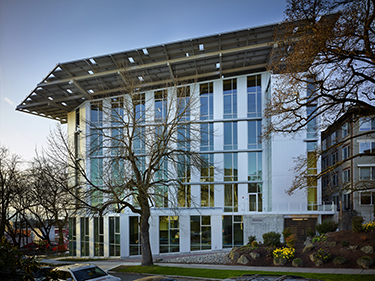|
Subscribe / Renew |
|
|
Contact Us |
|
| ► Subscribe to our Free Weekly Newsletter | |
| home | Welcome, sign in or click here to subscribe. | login |
Environment
| |
 |
February 26, 2015
Energy tools that could change the game
Paladino and Co.

Narayan
|
Washington state is laying the legislative rails for a transition to a low-carbon economy, as demonstrated most recently by Gov. Jay Inslee’s call for a carbon cap-and-trade program to limit carbon dioxide emissions.
The governor quotes studies conducted by the Western Climate Initiative that state by reducing carbon emissions through market mechanisms, Washington would benefit from a net increase of 19,300 jobs and increased economic output of $3.3 billion by 2020.
Several Northwest startups are poised to transform the energy-efficiency market, contributing to those impressive job growth and economic impact stats. Among them are Portland-based EnergyRM and Seattle-based buildpulse, each of which has introduced a game-changing product. EnergyRM’s DeltaMeter lets utilities pay for measured energy savings. Buildpulse lets building managers quickly identify issues with control systems, regardless of the system type.
Room for improvement
A city of Seattle benchmarking report gave insight into how improving buildings can lead to reduced carbon emissions, and more specifically, which buildings have the most opportunity to improve. The worst energy performers are buildings built between 1960 and the 1990s.
These buildings are typically low or mid-rise commercial and multifamily buildings. They may have limited or outdated heating, cooling, ventilation and lighting equipment and controls, which often require capital investment to upgrade. They also likely look “well loved” and don’t command market rate rents.
To be attractive targets for energy-efficiency investment, a rapid assessment of the business case is needed, followed by savings from low-hanging-fruit projects to build confidence towards (and perhaps fund) spending on deeper retrofits.
This where the Smart Buildings Center comes in. The Smart Buildings Center in Seattle is a nonprofit organization that supports growth and innovation in the Northwest’s energy-efficiency industry. The center was partially funded through the state of Washington as a vehicle for the market-based change.
One of the center’s primary goals is to increase building owner and investor confidence in energy projects by catalyzing the shift from predicted to measured energy savings. The center is funding studies that allow building owners to access the latest energy-efficiency technology while sharing the risk associated with using new products and approaches. The intent is to create a hub for knowledge transfer that both advances energy savings for the region as well as creates new jobs in the energy-efficiency field.
Identifying savings
Buildings from the 1960s-1990s are diverse in the way they are heated and cooled, and the way the heating and cooling equipment is operated.
Many of these buildings have controls systems ranging from basic thermostats to pneumatics to early direct digital control. This mixed bag means they become energy hogs because they likely aren’t performing the way they are meant to — such as heating and cooling spaces at the same time or with equipment starting and running outside of the normal occupied hours.
Seattle-based buildpulse is developing Web-based analytics software that can tap into your existing HVAC controls, regardless of system type, and identify issues and potential savings. What is unique about their approach is the speed at which information is gathered and the ability to run standardized queries on the systems remotely.
At most of the education buildings analyzed with buildpulse’s building runtime report, owners have identified that heating and fans run on average one to two extra hours beyond the occupied schedule (and sometimes all night and weekends). Reducing energy use during these unoccupied hours saves about 12 percent of their HVAC costs.
Once you have identified how you want the building to operate and understand how it is actually performing, the energy savings come from closing the gap between the two. However, utilities normally only provide incentives for capital-intensive measures, and the owners may not be willing to invest, especially where the building lease would share the savings with the tenants.
Thinking back to our problem-child buildings, there are usually opportunities to “close the gap” that come from tuneups rather than capital investment.
For example, rescheduling heating and ventilation systems to operate only during the times the buildings are occupied is a great way to save energy. And because occupancy patterns change month by month and year by year, there is an opportunity to revisit this energy-saving measure periodically to confirm the building is operating as efficiently as possible.
Meet MEETS
At the net-zero Bullitt Center, Seattle City Light and the building owners are pioneering a potentially game-changing power purchase agreement termed MEETS, or metered energy efficiency transaction structure. City Light pays the building owner for energy saved against a baseline, similar to the credits that homeowners receive when solar panels on their roof generate more energy than the house is using.
Making this incentive structure a reality relies on sophisticated technology that identifies how multiple factors (such as occupancy, schedule or weather) impact energy consumption, and comparing that to how the building actually performs at the utility meter.
By understanding the environmental factors that influence energy consumption, the utility knows it is paying for real energy savings rather than incidental savings coming from fewer occupants being in the building or unseasonably mild weather.
The DeltaMeter from EnergyRM is that technology bridge between the super-efficient office building and utility in the Bullitt Center.
Rob Harmon, president and CEO of EnergyRM, sees the DeltaMeter as a way to “enable a true ‘pay-for-performance’ market, including long-term power purchase agreements that will allow deep energy efficiency retrofits to join wind and solar as at-scale solutions for our energy system.”
The DeltaMeter operates in a transparent way so that the utility knows how the calculations are being done and can confirm to their board or shareholders that the savings are real.
At scale, this type of technology would allow owners of 1960-1990s buildings to bank utility incentives for whatever combination of energy savings technology or tuneup measures they decide are appropriate for their building. This additional cash flow may ultimately allow them to fund the capital upgrades needed to significantly reduce carbon emissions in Washington’s building stock.
Thulasi Narayan is a manager with Paladino and Co. Paladino is collaborating with the Smart Buildings Center in Seattle to evaluate new energy-efficiency products and tools.
Other Stories:
- Six reasons developers should build net-zero apartments
- Why green building has hit the wall, and what to do about it
- How to make a better business case for going green
- Making the most of your energy model
- Seattle is clamping down on waste from construction and demolition
- How to treat stormwater in urban areas — like Totem Lake
- Goal of Capitol Hill EcoDistrict is to make neighborhood green
- How to convince a realist it makes sense to go green
- How do you measure the value of a green building?
- Federal Center South team focused on results, not ratings



